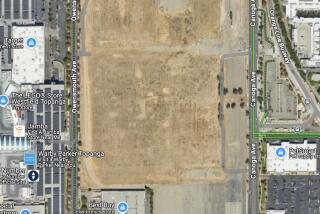Carson Plant’s Sewage Found Most Toxic : Waste Treatment: Sea urchin tests will bolster advocates of using stricter controls at plant. But what it dumps into the ocean meets state standards.
Ocean-bound effluent from the Los Angeles County Sanitation Districts’ giant sewage plant in Carson is significantly more toxic than waste from other Southern California treatment facilities with ocean outfalls, a study said.
The study, part of an annual report by the Southern California Coastal Water Research Project, shows that concentrations of key pollutants from the Carson plant do not exceed state limits.
But one test indicates the facility’s waste is significantly more toxic than that of six other ocean disposal plants studied in Southern California. The waste was found to be eight times more toxic, for instance, than effluent from the city of Los Angeles’ Hyperion facility near Los Angeles International Airport.
The results, obtained by comparing the effects of different effluents on sea urchins, are likely to add fuel to the current debate about whether the Carson plant should be subject to tighter federal treatment standards.
However, they also suggest that, even if the so-called secondary treatment standards are imposed, the toxicity of the plant’s effluent might still remain higher than that of other treatment facilities in the region.
The reason, experts say, is that such large quantities of industrial waste pass through the plant, which serves sanitation districts from Torrance to Pomona, sending 382 million gallons of effluent per day into the ocean south of the Palos Verdes Peninsula.
“The treatment level is not the whole picture. What is going into that waste stream is also important,” Jack Anderson, the director of the coastal water research project, said Wednesday. “Industrial effluent contains a higher proportion of chemicals that we know, at least in the soluble form, are toxic to marine organisms.”
Sanitation officials say 15% to 18% of the Carson plant’s waste--about 70 million gallons a day--comes from industrial sources, including 16 petroleum refineries, 30 chemical companies, and 600 metal finishing facilities.
Officials from the sanitation districts said Wednesday they had not yet thoroughly reviewed the report by the research project, which is a public agency formed in 1969 to conduct marine research in Southern California.
But Margaret Nellor, head of the districts’s industrial waste division, questioned the significance of the toxicity comparisons, saying the test involving sea urchins has not been perfected.
“I don’t think they’ve come far enough along with the sea urchin test to begin drawing conclusions,” Nellor said Wednesday. “I don’t know how much credence should be put in the results.”
Asked about that point, Anderson said: “We could always use more data, but I think no one would deny that this is a good indicator.”
The annual report summarized several studies. One, for instance, found that polluted storm runoff is less toxic to marine animals than effluent from sewage treatment plants.
The comparison of effluent toxicity, however, is likely to attract the most attention. In that test, sperm from sea urchins was subjected to mixtures of seawater and effluent from seven ocean disposal plants, including Southern California’s four largest--the Carson plant, Hyperion, Orange County’s facility at Huntington Beach and San Diego’s Point Loma plant.
The sperm’s ability to fertilize eggs was then measured. In the case of the Carson plant, major reductions in fertilization rates were noted with sperm exposed to effluent concentrations of 0.5%--significantly lower than the results of tests on effluent from other plants.
With Hyperion effluent, for instance, fertilization rates did not show major declines until sperm was used that had been subjected to effluent concentrations of 4% or higher.
“Comparing it across the board, one plant to the next, indeed the L.A. County plant effluent was more toxic,” Anderson said.
Environmentalists consider such results evidence that the Carson plant should not get an exemption from a federal requirement that sewage plants use secondary treatment, a system that makes use of biological processes to remove more than 85% of the solids from waste water.
The federal Environmental Protection Agency has tentatively rejected the sanitation districts’s request for a waiver, but last week the agency granted the districts’s request for a public hearing on the issue. EPA spokeswoman Lois Grunwald said a date for the hearing has not been set.
Sanitation officials have estimated it would cost ratepayers $350 million to upgrade treatment at the Carson plant, which already subjects 60% of its effluent to secondary treatment and the rest to less intensive screening.
They argue that effluent from the plant, since it is dispersed at sea, is not harming marine life. Sanitation officials also argue that removing more particles from the effluent would be dangerous because they help cap a layer of bay sediment contaminated by hundreds of tons of the pesticide DDT disposed of in the 1950s and ‘60s.
More to Read
Sign up for Essential California
The most important California stories and recommendations in your inbox every morning.
You may occasionally receive promotional content from the Los Angeles Times.









